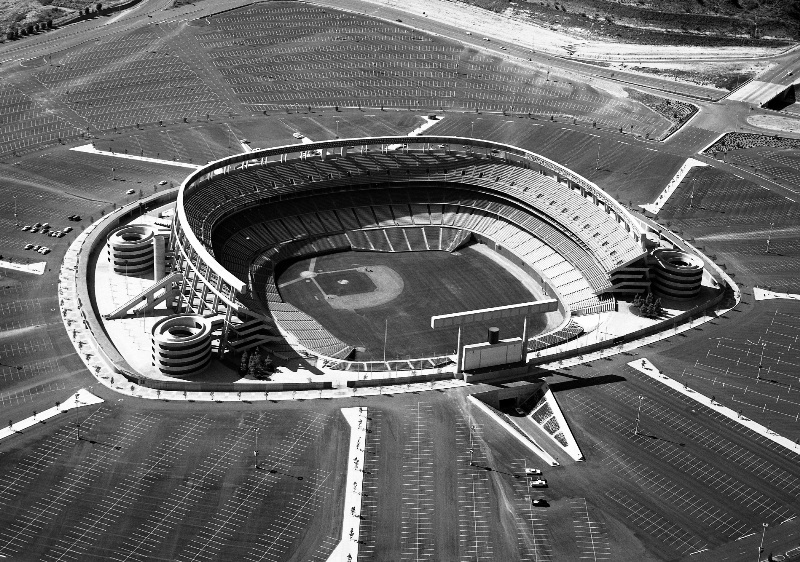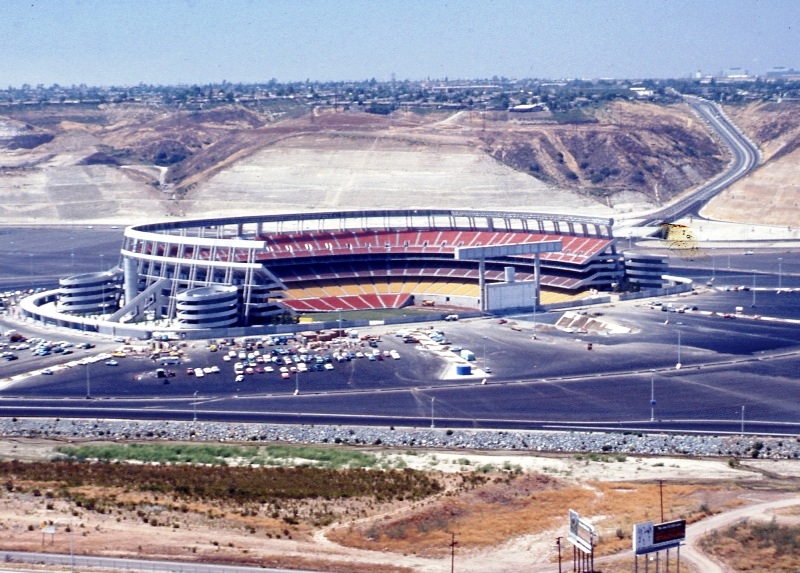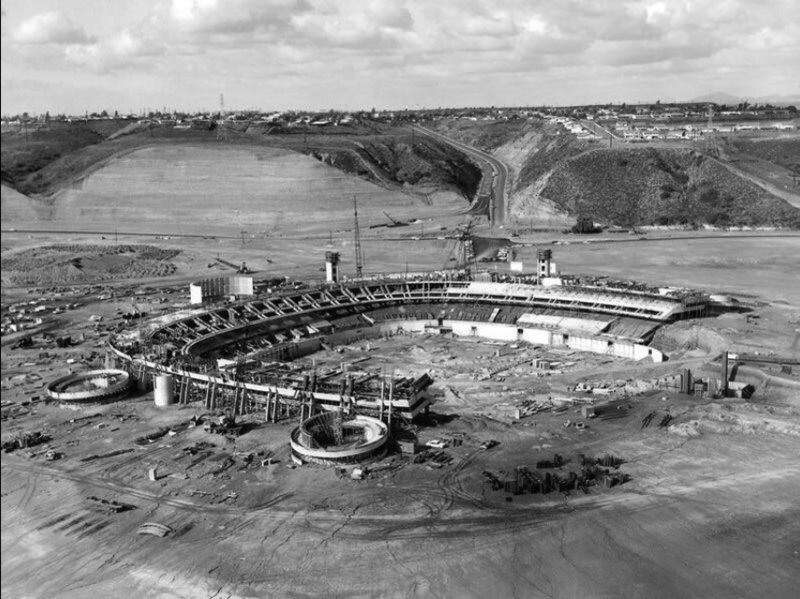The year 1969 was a big one in Major League Baseball, as four expansion teams were added to the mix. Over the next four weeks we’ll look back at the four expansion ballparks, starting with one still standing: the original San Diego Stadium.
With referendums scheduled, the future of SDCCU Stadium—the original home of the MLB San Diego Padres—is pretty much sealed, as we approach the end of an era in the San Diego sporting scene.
Unlike many of the new sports facilities of the era, San Diego Stadium was never designed as a circular cookie-cutter facility, but it was designed to host both pro football and pro baseball. The original design, shown at the top of this page, was a modern take on an old stadium design: the horseshoe. As you can see, there’s nothing in that original that screamed baseball, and even during the final days of the Padres’ tenure, the facility was clearly more a football stadium than a baseball ballpark.
In fact, the San Diego Chargers were the first full-time tenant at San Diego Stadium after team owner Barron Hilton moved his AFL franchise from Balboa Stadium, a historic facility first opening in 1914 and expanded for the Chargers. The minor-league San Diego Padres played their 1968 season at San Diego Stadium before the major-league squad took the field for the 1969 season.
Major League Baseball expansion work officially began in 1967, when Charlie Finley proposed moving his Athletics from Kansas City to Oakland. Finley’s tenure as the A’s owner was a rocky one; after an early honeymoon period, local fans tired of his unstable management of the team, both on the field and in the front office. Kansas City officials had been working on a plan for a new ballpark to replace Municipal Stadium, but Finley didn’t believe they would follow through if he still owned the team. His move triggered a series of moves that included an influential senator, Stuart Symington (D-MO), claiming he’d work to revoke MLB’s antitrust exemption if Kansas City had to wait until 1971 for expansion, MLB’s preferred timeline. So expansion was moved up two years. San Diego was an easy expansion candidate, with a stadium and local ownership group ready for Major League Baseball.
That original iteration of San Diego Stadium featured a horseshoe design from local firm Frank L. Hope and Associates, a design remaining mostly intact until 1997, when the stadium was fully enclosed, and the capacity boosted to 70,561. The horseshoe itself featured permanent seating, while temporary seating was installed for baseball games, creating a curved grandstand around the infield. The open end of the horseshoe faced the east, providing a nice view of the Cuyamaca Mountains.
The Padres were always a secondary tenant at San Diego Stadium, to be sure. In his book Cradle of the Game, Mark Cryan interviewed former Padres GM Jack McKeon about his years in baseball, ranging from minor-league runs in North Carolina and Omaha to his days with the San Diego Padres and the then-Florida Marlins. Here’s a portion of that interview relating to San Diego:
MC:
Was it any different dealing with those types of ballpark issues in the big leagues?
JM:
Hell no. In San Diego, I had a running battle with the city manager on the front page of the paper the year we went to the World Series. The field was so bad they had to dye it with vegetable dye. [Outfielder Kevin] McReynolds slides to catch a ball, and he comes up with his pants all green.
Well, we won the pennant, and we’re supposed to be playing the World Series and they’re getting ready for a football game on Sunday. We’re getting ready to get out of town, and I go out there, and they’re digging these holes in the outfield for where they roll the stands out. Well, when they set back up for baseball, balls are going this way and that. I go nuts. We wind up in front of the stadium commission. Finally, we got rid of that groundskeeper and brought in Bill Wilson. Smooth sailing then.
After we were in the Series, Ballard Smith, the president of the club, was negotiating a new lease, and he’s gonna bring in this gal from the PR firm. Well, he and Dick Freeman are working on this thing, and Freeman doesn’t want to make anyone mad, he likes being invited to the Poinsettia Bowl and all the black-tie cocktail parties. I said, let me negotiate it. I’ll just tell them we’re going to Denver. Freeman says, “No, you can’t do that….” I tell him, I won’t tell them, I’ll just, you know, insinuate…
Let me give you an example of how bad our situation was there. They had all these extra rooms in the stadium and the Chargers had everything, but we didn’t even have a batting cage under the stands. These guys finally got a room we could use, but the team winds up spending $325,000 converting it into a batting cage!
In the end, he and the PR firm did the lease, and I said, you’ll wish you had let me negotiate it. So, 10 years later, they sold the club, and Larry Lucchino comes in and says the team has the worst lease in baseball!
The facility was known by several names over the years. In 1981, the stadium was renamed for longtime San Diego Union sports editor Jack Murphy, who helped bring the Chargers, Padres and the stadium to fruition. The lure of naming-rights dollars was too strong for local officials to ignore, so Qualcomm Stadium came into being in 1997. SDCCU Stadium, in a deal with San Diego County Credit Union, came to be when the Qualcomm naming-rights deal expired in 2017.
SDCCU Stadium still stands as the home of the SDSU football team, but that will not last indefinitely. Today (Nov. 6) San Diego voters will be asked to evaluate two referendums that would lead to the stadium’s demolition in favor of either a mixed-use development featuring an MLS stadium or an extension of the SDSU campus, anchored by a new Aztecs stadium that could also potentially host MLS soccer and NFL football. It will take time for any redevelopment or demolition to begin, but when it happens, it will mark the end of an era for SDCCU Stadium, the facility that brought San Diego into the big leagues.
Images courtesy City of San Diego.
This article first appeared in the Ballpark Digest newsletter. Are you a subscriber? It’s free, and you’ll see features like this before they appear on the Web. Go here to subscribe to the Ballpark Digest newsletter.



